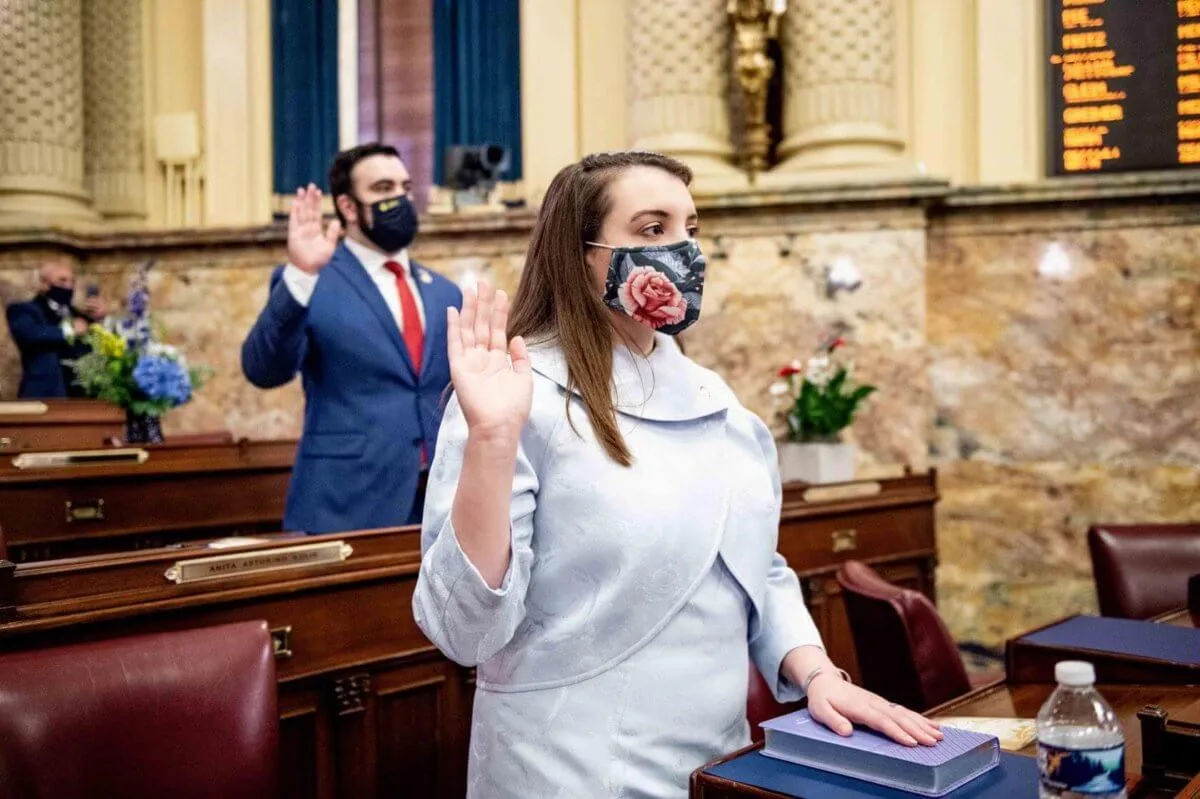
State Rep. Jessica Benham is sworn in on Jan. 5, 2021. Benham is the first openly queer woman and openly autistic person elected to the state Legislature. (Courtesy of Pennsylvania House of Representatives)
Women make up approximately 51% of the state population, but just under 29% of the state Legislature. Several groups are working to change that.
HARRISBURG — When freshman state Rep. Jessica Benham walks in to work at the state Capitol, she walks into a chamber that’s still filled with mostly old white men.
And it’s strange because this group that is supposed to represent the state does not represent the makeup of the state; 51% of Pennsylvania’s population is female.
“I think it’s really important to have people whose lived experiences reflect the diversity of our commonwealth,” said Benham (D-Allegheny).
That’s why she’d like to see more young people in office, more people of color, more members of LGBTQ communities, more people with disabilities. And, yes, more women.
“We need to get it to the point where minimally it’s 50/50,” said state Rep. Pam Snyder (D-Greene).
State Rep. Mary Isaacson (D-Philadelphia) agreed: “We should have proper representation.”
Getting to that point, however, still includes many obstacles. Some are institutional. Some are financial. Some are societal.
“It’s still really hard,” said Christine Jacobs, Executive Director of Represent PA. “It’s really hard for women with young children. It’s really hard for women who don’t have financial backing of their own. If you come from a family that isn’t a traditional political family, it’s hard.”
The growing number of women in the state Legislature and new organizations whose purpose is to get women to run for—and win—office across the state are working to make it easier.
“This profession has been dominated by men for so long that I think it’s hard for some folks to see a woman in elected positions,” Snyder said. “We are breaking through that stereotype.”
The Women in Pennsylvania’s Legislature
A record number of women (74) were sworn in to the state Legislature this year, but they still make up just under 29% of the state Legislature.


The 59 women in the state House of Representatives make up 29% of its population. A special election this May in the 59th District will add one more, since both candidates for that seat are women.
The state Senate falls just below that; 14 of its 50 members are women, making up just 28% of the upper chamber.
Both of those numbers might be high water marks in each chamber, but the total is still below the national average of 30.9%, according to data compiled by Rutgers University.
Pennsylvania’s Trailblazing Women
It took Pennsylvania 135 years to elect a woman to its state Legislature. And in 1922, it elected eight.
Since then, progress has been slow, but somewhat steady.
The percent of women in the state Legislature remained consistently below 7% until the 1990s. In 1991, 21 women were in the state House and another four were in the state Senate, which put women’s representation in the state Legislature just under 10%. The 1992 election, which was dubbed “the Year of the Woman” for the number of women elected nationally, increased the number to 11%.
Women’s representation in the state Legislature topped 15% in 2001 and 20% in 2015.
That growth has meant a lot of positive change.
“It’s incredible to see the massive amount of women stepping up to run,” said Rebecca McNichol, who runs Emerge Pennsylvania, a group that trains Democratic women who are running for office.
Elected Women Inspire Other Women to Run for Office
Vice President Kamala Harris has famously said she “may be the first woman [to hold her office], but I will not be the last.”
Then there’s Sen. Elizabeth Warren (D-Massachusetts), who had a strong base of support in the 2020 Democratic Primary. Sens. Lisa Murkowski (R-Alaska) and Susan Collins (R-Maine) can make or break legislation with their swing votes.
Many of the prominent new members of congress the last two election cycles have been women: Rep. Katie Porter (D-California) is famous for her white boards, while Rep. Alexandria Ocasio Cortez (D-New York) can fire up her fans and critics with a Tweet or raise money for Texans in need after a brutal ice storm.
Even former President Donald Trump’s second impeachment highlighted elected women, with Reps. Stacey Plaskett (D-Virgin Islands) and Madeleine Dean (D-Pennsylvania) catching the national spotlight for their work.
Representation matters. Seeing women in office inevitably inspires more women to run for office.
“I think it’s extremely important,” said Snyder, the state representative. ”We want to encourage more women to seek public office—at all levels, from local school boards and local municipalities to state and federal offices.”
Jacobs, of Represent PA, said she remembers growing up “in the Walter Cronkite era, where a man’s voice was the voice of authority.”
Now, Jacobs sees a country whose dominant voices include women of all colors, backgrounds, and cultures.
“Who’s more authoritative than Elizabeth Warren or Kamala Harris or even Liz Cheney,” Jacobs asked.
Girls and young women see leaders all over the state and country who look like them. It plants a seed. They, too, can do it.
The First Challenge Women Face in Running for Office: Incumbency
One of the biggest obstacles standing in women’s way is a simple one: incumbency.
Roughly 95% of incumbents nationwide won re-election in 2020 in state-level elections, according to Ballotpedia.
In Pennsylvania, 95.6% of incumbents won re-election in 2020. Approximately 97% of incumbent state representatives who ran for reelection won, and 82% of incumbent state senators who ran for reelection won.
“Women, people of color, young people, tend to be the challengers,” said Dana Brown, the executive director of Chatham University’s Pennsylvania Center for Women in Politics.
That’s quite an uphill battle.
The Second Challenge Women Face in Running for Office: Planning
“It’s bigger than just getting into office, it’s the backstory of how an individual woman gets prepared,” said state Rep. Darisha Parker (D-Philadelphia).
Women have to understand that they need to begin planning a run about two years in advance, Parker said. A woman who wants to run for the state Legislature in 2022 needs to start now.
“My question to women,” Parker said. “Are you ready to carry that mantle? Because it’s a heavy mantle for you to carry.”
They need to have conversations with people in their life about the sacrifices they’re going to make, Parker said.
Then they have to start networking, fundraising, and hiring staff.
The Third Challenge Women Face in Running for Office: Networks and Fundraising
Many members of the state Legislature spent time working as chiefs of staff for their predecessors or other elected officials, which helped them make connections with legislators, party leaders, policy experts, and donors. Women traditionally worked in the communications department, which didn’t give them the same level of information and access.
“Having more women both on the campaign side, working for consulting firms, and also on the official side” would help, Brown said.
Fundraising is another issue. Traditionally, some political scientists have said that women don’t bring in money like men do.
It’s true that men might run in some circles that generate more money more easily. For example, men are still more likely to be partners at a law firm.
“The money networks still largely rely in men-dominated areas,” Brown said.
However, women can raise the same amount of money, it just might take them a few extra phone calls, Brown said. Women made dramatic increases in campaign donations at the state level last year.
“We know that campaigns cost money, so we have to invest in women as leaders,” said state Rep. Donna Bullock (D-Philadelphia).
The Fourth Challenge Women Face in Running for Office: Sexism on the Campaign Trail
“Running for office is not easy,” Isaacson said. “When you put yourself up for office, you’re putting yourself up there to be judged and it’s not always the most pleasant process.”
Sexism is the elephant on the campaign trail.
It shows up when people with no political experience tell women how to style their hair or how much to smile. Everyone has an opinion about what is feminine and professional.
Then there’s body ink.
Lt. Gov. John Fetterman has several tattoos. Stories in local and national news media often talk about the ink to make Fetterman sound relatable to the working class.
Ask Emily Skopov about how the tattoo on her left arm was treated during her race for the 28th state House District and you can practically hear her eyes roll at the experience.
Skopov has a master’s degree from Columbia University. She has had a successful career as a screenwriter, businesswoman, and founder of a nonprofit. It’s a resume most political candidates would envy.
But Skopov’s tattoo wasn’t treated as a way to relate to the working class.
Asked about the differences in how they were treated by the press and the public, Fetterman said, “It’s time to elect the best candidates and let go of judgments and biases about what a woman chooses to do with her body: how she dresses, how she expresses herself, and how often she smiles.”
Skopov can also point to another area where women get different treatment: Her resume might not be listed on TV chyrons or website headlines while the fact that she’s a mother is.
Fetterman, US Sen. Bob Casey, US Sen. Pat Toomey, and Gov. Tom Wolf are all fathers who have been elected in statewide races. No headlines calling them “father of …” could be found for this story.
Another critique women have to deal with is the way they speak.
“When a man speaks forcefully, he’s being strong,” Isaacson said. “Women can be perceived as shrill or bitchy, whatever word you want to use for it.”
Isaacson said that issue might be getting better, as younger generations are more understanding and nuanced.
“I think that when I started in politics it was worse,” said Isaacson, who was her predecessor’s chief of staff before she won election to the state house in 2012. “But I think that with more women getting elected, (accepting women has) become more commonplace.”
It’s a constant battle on the campaign trail dealing with these biases.
“Whether people recognize it or not, those things exist,” Isaacson said. “It’s an issue that women face every single day in the workplace.”
Extra Challenges for Women of Color Who Run for Office
Pennsylvania was the first state to elect a Black woman to its state Legislature, when Philadelphia voters sent Crystal Bird Fauset to Harrisburg in 1938. Since then, 25 Black women have served in Pennsylvania’s Legislature.
Bullock, the state representative from Philadelphia, has been in the legislature since 2015. During her tenure, the number of Black women in the Legislature has been consistent: nine. It hasn’t always been the same women, but the number has always been nine.
“And that is the most that we have ever had at any single time in our state Legislature,” she said.
Those nine women make up 3.56% of the state Legislature. Meanwhile, Black women make up approximately 6.34% of the state population.
The percentage of Black women in Pennsylvania’s Legislature is lower than the national average of 4.82%, according to data from State Innovation Exchange.
Bullock said the experience is similar for Black women in the workplace everywhere.
“There are challenges around the perception of Black women and how we are to carry ourselves in this space,” she said.
Bullock does see positive change.
“What is great about the nine Black women that are right now in the Capitol is that we are in positions of leadership,” she said.
State Rep. Joanna McClinton (D-Philadelphia) is the first Black woman to serve as House Democratic Caucus Leader. Bullock leads the Black Caucus. Rep. Margo Davidson (D-Upper Darby) is the Democratic Chairwoman of the State Government Committee.

More Support for Women Running for Office in Pennsylvania
Pennsylvania—and the nation—has seen a growing number of groups whose main purpose is to get women into elected office. Some are partisan, while others cross party lines. Some are independent in individual states, while others are national organizations with groups in each state.
These groups can offer more than money. They can provide training and networking opportunities, which can be useful for when it comes to a candidate organizing staff, figuring out fundraising techniques, or getting ready for media interviews.
These groups are “extremely important because there is no class or degree to find out how to actually run for office,” Isaacson said.
Three groups that repeatedly came up in conversation in Pennsylvania are Emerge, She Can Win, and Represent.
She Can Win is a non-partisan organization that trains women to run for office and invests in campaigns for women of color.
Emerge runs a six-month long course that gets into the ”nuts and bolts” of a campaign, McNichol said.
The group will celebrate its sixth anniversary this month.
Emerge’s alumnae list includes Democratic state Reps. Liz Hanbridge, Kristine Howard, Jennifer O’Mara, and Melissa Shusterman, and state Sens. Maria Collett, Carolyn Comitta, Katie Muth, and Lindsey Williams.
She said the network the women develop has already helped their constituents at the municipal level.
“We even experienced that this year,” she said. “In 2019, we had a significant number of women that won municipal races. They were sworn in in January 2020, and by March were dealing with COVID.”
Those women had a support network they could turn to to see how others were dealing with the pandemic, McNichol said.
“That was really helpful—connecting women to other women,“ she said.
For Jacobs, the big thing is helping women get money to run. That’s what her political action committee, Represent, is concerned with. They want to put money in candidates’ hands.
Even money for some expenditures in the primary can help. When a woman wins a primary, that’s important, too, she said. It’s another obstacle knocked out of the way.
Jacobs will tell you she’s been in politics for a long time and that she’s seen a lot of change over the years, and women aren’t done.
Not even close.
“It’s a hard climb,” she said, her eyes as always on the future. “We’re working on 2022. We’re working on evening the playing field.”
Hope for the Future of Women in Office in Pennsylvania
Benham, the freshman state representative, thinks leveling the playing field will mean better legislation for all Pennsylvanians.
“Who else should be here in the rooms where decisions are being made? Who else should be part of this decision-making process,” Benham asked. “And of course, it’s more women, of course it’s more Black and brown people, it’s more people with disabilities, it’s more LGBTQ people, it’s more working class people. Because when we’re making decisions that impact marginalized people, those people should be part of the decision-making process, too.”
Correction: This article was edited on March 20, 2021 to clarify the nature of She Can Win’s work.
Politics

Influencers and creators find new ways to engage young Philadelphia voters
Rec Philly, a space for creators and influencers, teamed up with Show Up Strong to get hundreds of young Philadelphia residents engaged in the...

New Biden rule protects privacy of women seeking abortions
Under the new rules, state officials and law enforcement cannot obtain medical records related to lawful reproductive health care with the goal of...

Biden marks Earth Day by announcing $7 billion in solar grants
The Biden administration on Monday announced the recipients of its Solar For All Program, a $7 billion climate program that aims to lower energy...
Local News

Conjoined twins from Berks County die at age 62
Conjoined twins Lori and George Schappell, who pursued separate careers, interests and relationships during lives that defied medical expectations,...

Railroad agrees to $600 million settlement for fiery Ohio derailment, residents fear it’s not enough
Norfolk Southern has agreed to pay $600 million in a class-action lawsuit settlement for a fiery train derailment in February 2023 in eastern Ohio,...





